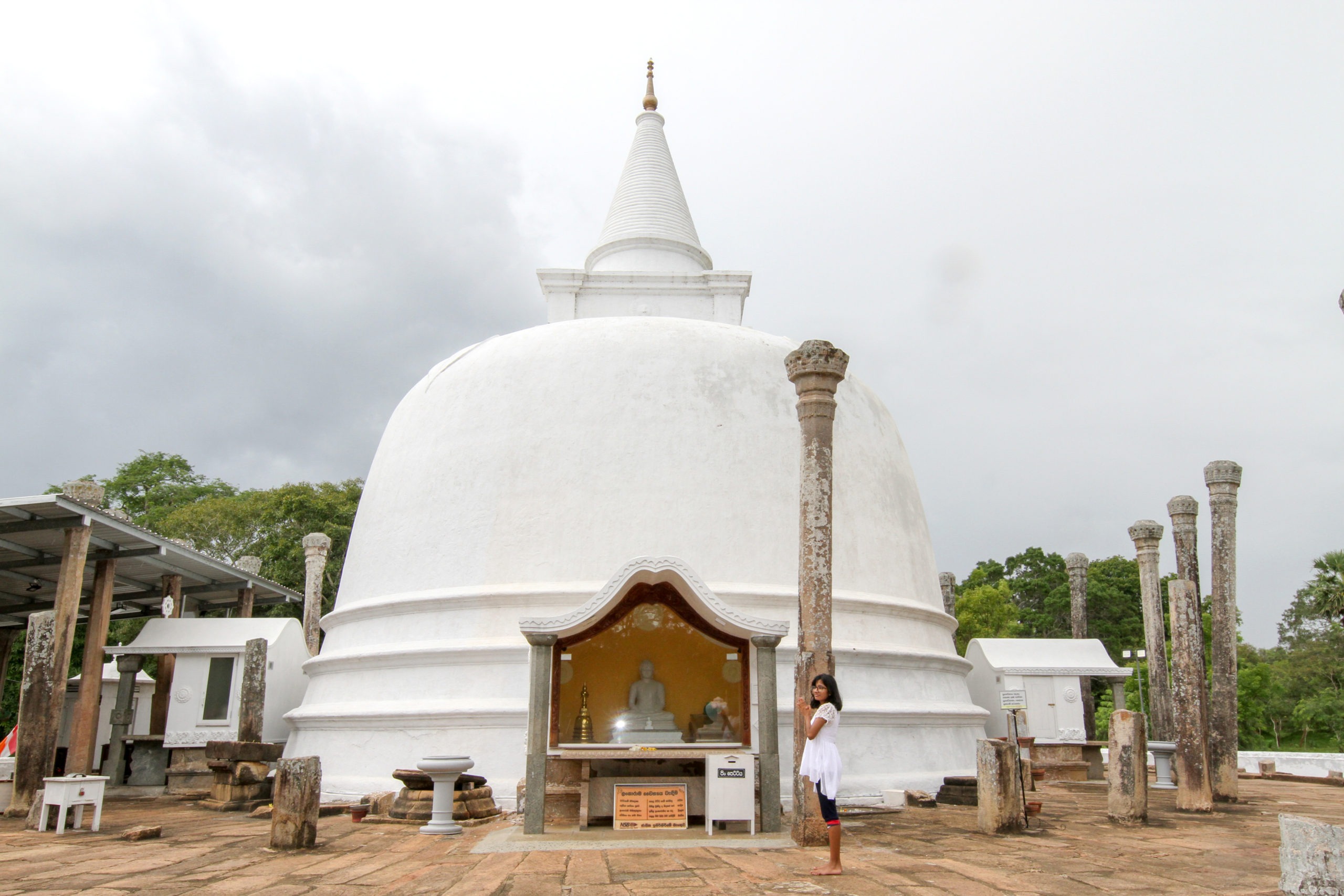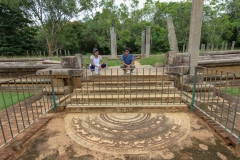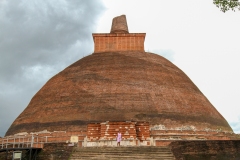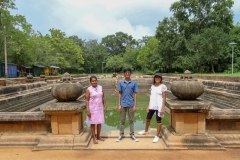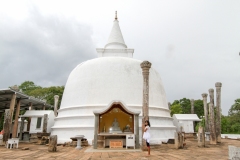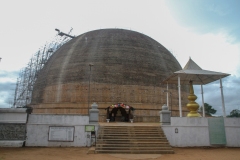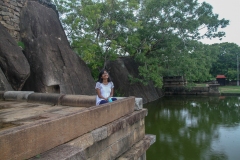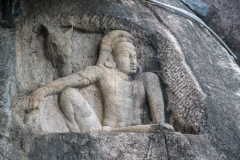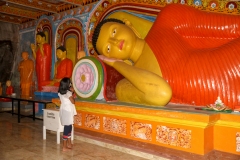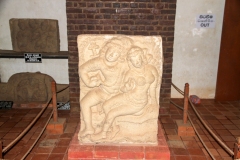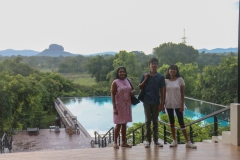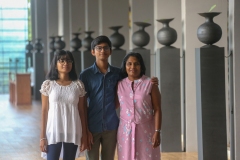The road trip started at around 12.30 noon and we took a detour to Kurunegala. After nearly 5 hours of driving we reached Aliya Resort & Spa in Sigiriya, we were exhausted and tired so we immediately ate dinner and went to recharge our batteries. The hotel was very precautious about the coronavirus pandemic. The staff made sure to sanitise everything and anything and follow all the strict regulations set by the government to insure the safety of the guests. Not to mention, that the hotel is beautifully surrounded by nature and lush greenery even the Sigiriya Rock Fortress is clearly visible from the reception area itself, it also has several amenities accessible by the guests like the spa, disco, karaoke and much more. This is our second time staying in this hotel and both times we greatly enjoyed it. We would really like to thank the Mr. Chandra Wickramasinghe, Chairman of Theme Resorts & Spas, one of the pioneers of Sri Lankan tourism due to the successful and innovative ideas put in place to this hotel. Anyways, the next day we started the morning with a delicious meal and left to Anuradhapura at around 7.30am to explore the ancient but magnificent ruins, sacred sites, temples and everything in between.
Aliya Resort & Spa, unique amongst other Sigiriya hotels
Nestled among the lush greenery of rolling fields, decades old indigenous trees and chena growth of the dry zone of the Central Province, Aliya Resort & Spa Sigiriya invites you to relax and unwind, far from the hustle and bustle of city life. https://vouchers.themeresorts.com/
Anuradhapura
One of the most significant and sacred cities that belong to the ancient world, Anuradhapura was the first capital of Sri Lanka. Hosting UNESCO world heritage sites this city is the core of Buddhism and its people due to its grandeur history and the vast array of Buddhist monuments that dates back to more than 2000 years. The largest brick monuments of the world named, Jethavanaya and Abhayagiriya were situated there. Sri Mahabodhi the sacred Bodhi tree shrine of the Mahaviharaya which was planted in the 3rd Century B.C. .
King Devanampiyatissa (250-210 BC) having donated to the bhikkhus the Nandanavana and Mahameghavana located near the southern entrance built the first Sangharama (Monastery) within the Mahameghavana. This was first named ‘Tissarama.’ Later it came to be known by the names of ‘Mahameghavanarama’ and ‘Mahavihara.’ Since then Mahavihara was the headquarters of the community of Sri Lankan bhikkhus for centuries. It is by the bhikkhus of Mahavihara that the Triptaka and the Commentaries (atthakatha) were committed to writing. Mahavihara exerted direct influence on religious, political, economic, social and cultural fields of the island. Within this zone could be seen the Sri Maha Bodhi, Ruvanveli Seya and Thuparama
Ruvanveli Maha Seya
Of the stupas built in Sri Lanka Ruvanveli Seya is the first stupa that is worshipped with great reverence. Hence it is known as ‘Mahathupa’ (Great Stupa) and Ratnamali, Mahaseya and Swarnamali Seya in various literary works. This stupa was built by King Dutugemunu (161-137 BC) Bubble-shaped in form; a large number of bricks had been used for the foundation. It is about 150 ft in height. It is mentioned that paintings had been done in the relic chamber. After King Saddhatissa, most of the rulers who became kings not only in Anuradhapura but also in the entire country had contributed towards it restoration. A unique feature in this stupa is the elephant-faced wall between the stone-paved terrace and the flight of steps. Similarly, there are four vahalkadas in the four directions. After subsequent restorations the stupa is 350ft in height and 300 ft in circumference. Ruvanveli Maha Seya is an important monument that has received the veneration of both local and foreign Buddhists and as a mark of reverence a special offering of one hundred thousand jasmine flowers is made in July each year.
Thuparama
Thuparama is the first stupa built in the country after the introduction of Buddhism in the third century BC. According to Mahavamsa it has been named Thuparama because the stupa and the monastery (arama) complex are located together. The stupa has been built by King Devanampiyatissa enshrining the right collar bone of the Buddha. The stupa has been subsequently renovated by kings of Anuradhapura and Polonnaruva. A unique architectural feature here is the vatadage (round relic chamber) built around the stupa, which has been built by King Vasabha (65-109 AC). The present height of the stupa is 63 ft and the diameter 59 ft. Among the surrounding buildings are the building supposed to be that of a hospital, an image house, a bhikkhuni arama and an uposathaghara (chapter house).
The second largest of the stupas in Sri Lanka, Abhayagiri Stupa has been built by King Vattagamini alias Valagamba (89-77 BC). This extends up to an extent of nearly 200 hectares. According Bhikkhu Fa-hsein who visited Sri Lanka in the fifth century there had been three thousand resident bhikkhus in the Mahavihara and five thousand bhikkhus in the Abhayagiri. The development of Abhayagiri reached its peak in the reign of King Mahasen and was the centre of Mahayana Buddhism. Buddhist buildings found in the environs of Abhayagri indicate that this complex had been an important educational institution both locally and internationally.
Abhayagiri Stupa
The Abhayagiri Stupa built by King Valagamba in the first century BC had been known by various names such as Utara Maha Ceta, Abhayagiri Dagaba, Apahayagara, Bagirinaka, and Bayagiri. In the original Abhayagiri Stupa there had been three basal rings (pesa valalu), hataraskotuva (the cubic superstructure), spire and the umbrella. On the four sides of the stupa are four gateways (ayaka), stone-paved terrace, elephant wall, sand court, wall and gopura. The bahirava figures of Sankha and Padma on either side of the southern gate are exquisite examples of sculpture. Even at present various religious performances and rituals are held in association with these figures. There is evidence that the eastern gateway contained paintings. It has also been possible to discover a Sri Pada (sacred foot print) in the stupa terrace. The present height of the stupa is 235 ft and the diameter at the base is 310 ft.
Samadhi Buddha
Statue is considered as a creation that depicts the skill of the sculptor of the Anuradhapura period. The statue which is in deep contemplation pose is believed to belong to circa fourth century. It is in the veerasana pose reflecting concentration and is made of dolomite. There is evidence that the body and the robe had been painted. The robe that covers only one shoulder seems to have been glued to the body. The statue is exquisite in depicting Buddha’s deep meditation, which is expressed both by the face and the body. In excavations done in about 1960 evidence has been discovered that there had been a bodhighara (Bodhi-tree shrine) here. This is known as the bodhighara of Abhayagiri Vihara.
Moonstones
The best specimens of moonstones found in Sri Lanka are from Abhayagiri Vihara. The moonstone No.1 is believed to be the best creative work of art in conception and execution. Because of the realistic portrayal of animal figures and the delicacy of carvings such as creeper motifs, art historians believe that it is an outstanding specimen of stone carving. The No 1 moonstone is seen near a pancavasa now known as the Mahasen’s Palace in the Abhayagiri complex. About the carvings in the moonstone scholars express various opinions. Prof. Paranavitana in interpreting the carvings refers to Buddhist concepts. According to him the moonstone symbolizes samsara, the endless cycle of birth and death, and the path to freedom from this cycle leading to Nirvana. The moonstone No 2 also is based on the same form as the above moonstone. This is found near the so-called Queen’s Pavilion on the hillock near the Ratnaprasada.
Kuttam Pokuna
The Kuttam Pokuna is a superb example of Sri Lankan art and technology. It is believed that these ponds had been built for the water needs of the resident bhikkhus of Abhayagiri Vihara. Probably built in the eighth or the ninth centuries, there are terraced stone steps in both ponds to reach the water. Water to the ponds had been first carried to the yard surrounding the ponds and then through the ‘dragon mouth’ in the small pond and to the bigger pond through an underground conduit. Water in both ponds had been drained away through an outlet at the bottom of the small pond. An excellent work of art is the five-headed Naga symbol sculptured at the entrance to the ponds.
Jeetavanarama
Jeetavanarama was built by King Mahasen (276-303 AC). King Mahasen was a follower of Mahayana Buddhism. Jetavanarama is distinctive because of its large stupa. The premises where the Jetavanarama is located earlier belonged to the Nandana Park. It is the place where Thera Mahinda preached the Dhamma for seven consecutive days. Complete with all the buildings needed for a monastery, buildings here, in addition to those built by King Mahasen, had been constructed by Kitisirimevan (303-331 AC) and kings who succeeded him.
Jetavanarama Stupa
The Jetavana Stupa built by King Mahasen is about 400ft in height and it is the third largest monument in the world and the tallest brick-built monument. During a recent excavation, nine gold folios containing a Mahayana Sutra, the Pragnaparamita Sutra, were discovered. There are four vahalkadas (frontispieces) facing the four cardinal directions of the stupa. The stupa has been built on a mound higher than the ground level. Archaeological excavations have revealed the remains of an elephant wall around the terrace. Excavations have also revealed various coins, Chinese ceramic ware and other special artefacts. This stupa has now being completely restored by the Central Cultural Fund.
Pratimaghara (Image House)
Image House is a singular architectural feature at Jetavana. It has also been known as ‘Manimevula Prasada.’ The monolithic door jamb is 27ft in height. The image house is the largest of the kind found in Anuradhapura or Polonnaruva. The padmasana (lotus pedestal) seen here suggests that there had been a large statue of the Buddha. It is calculated to have been about 37ft in height. The remains of a yantragala (stone reliquary) are also seen beneath the lotus pedestal. It is mentioned that this has been built by King Sena I (833-853 AC) in the ninth century and that he had deposited a gold Buddha statue here.
Ayubowan Srilanka 6 – Anuradhapura

 Русский
Русский සිංහල
සිංහල


